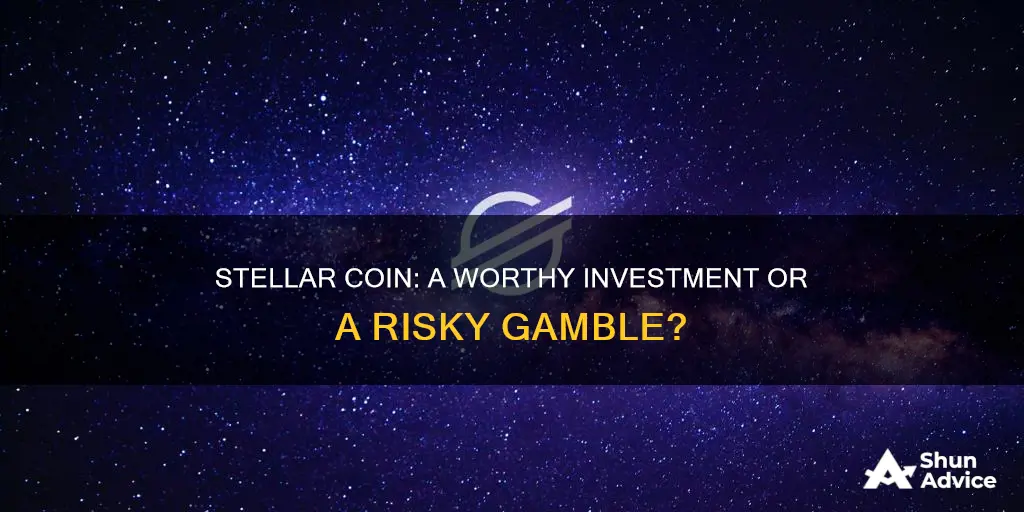
Stellar (XLM) is one of the most competitive long-lasting tokens, having been launched in 2014, even before Ethereum. Stellar is a platform that connects banks, payment systems, and people, and is best suited for completing cross-border transactions quickly and efficiently. Stellar's partnership with IBM has been a significant boost, with IBM providing the Stellar Network with 8 validating nodes and pitching the technology to its banking customers. Stellar's decentralised nature and fast settlement system have been touted as a potential replacement for the Ripple and Bitcoin networks. However, the recent bear market has mauled Stellar, causing it to lose over 90% from its all-time high. So, is Stellar a good investment?
What You'll Learn

Stellar's partnership with IBM
Stellar has established some good partnerships, including with IBM, Stripe, Deloitte, and Shift Markets. IBM has been publicly building distributed ledger products on top of Stellar (XLM) since October 2018. IBM provides financial institutions with Stellar-based products for validating the Stellar public network, facilitating cross-border transactions with lumens (XLM) as the current bridge asset, and issuing any asset on the Stellar network. IBM's clients include larger, more risk-averse institutions like banks and central banks.
IBM's value-add is its validating and operational presence on the public Stellar network, which makes it more attractive for enterprises to deploy assets and solutions on publicly accessible blockchain networks. IBM provides a private, permissioned solution via Hyperledger that can be extended to a public solution on Stellar. IBM's Blockchain Platform strategy provides a toolkit to create secure private blockchain networks using Hyperledger Composer and Fabric, as well as interoperability with public networks such as Stellar.
The Stellar Development Foundation (SDF) joined the Hyperledger Foundation as an associate member, adding a 'coin' capability to Hyperledger Umbrella. IBM runs validators (nodes) in the Stellar network, providing a major validating presence that adds enterprise/permissioned capabilities for asset issuers and transaction processing for cross-border payments.
IBM's Universal Payment Solution, built on top of the validation layer, allows banks to quickly clear and settle cross-border transactions on a single network, speeding up the costly and laborious process of making global payments in different currencies. This solution is live in the South Pacific, matching currencies across 13 countries and 7 trade lanes, using a bridge asset to reduce the clearing and settlement process time from 3-5 days to near real-time.
IBM's cross-border payment solution leverages lumens (XLM) as a bridge asset to facilitate real-time foreign exchange for the final settlement of payments. While XLM is currently the bridge asset, IBM clients will be able to use other bridge assets in the future, such as central bank digital currencies (CBDCs).
The partnership between Stellar and IBM has significant implications, with the collaboration cementing Stellar as the next global financial system. The XLM coin will be the transaction vehicle, and with IBM's global market penetration, it is expected to gain increased value and market liquidity as more investors join the Blockchain World Wire (BWW) project.
Stellar's low transaction costs, AML and KYC compliance, and superior smart contracts also make it an attractive platform for investors and businesses.
How to Invest in Bitcoin as a Minor
You may want to see also

The future of the crypto market
The crypto market has experienced unprecedented growth over the last 18 months, with the number of cryptocurrency investors steadily increasing around the world. This growth has been driven in part by the pandemic, which left many consumers with more time on their hands and fewer activities to spend money on. As a result, consumers have forayed into crypto trading, with Reddit threads about "stonks" and "diamond hands" pushing thousands to collectively inflate the price of certain assets.
This has led to the emergence of "meme stocks", which have breathed life into defaulting companies like GameStop and AMC, shaking the market to its core. The global cryptocurrency market is estimated to more than triple by 2030, hitting a valuation of nearly $5 billion.
However, the future of the crypto market is uncertain. While investors believe in regulation, they are concerned about its impacts, and while they are eco-conscious, crypto has a large carbon footprint. The institutional money entering the market and the potential for crypto to be floated on the Nasdaq could bring greater credibility to blockchain and its uses as an alternative to conventional currencies.
The future of crypto lies in joining the financial and regulatory establishment, not rebelling against it. Crypto will work best in conjunction with other financial networks, not as substitutes.
The crypto market also faces challenges in terms of regulation and government scrutiny, which erodes the fundamental premise for the existence of cryptocurrencies. The more popular they become, the more regulation and scrutiny they will attract. Additionally, the relative complexity of cryptocurrencies compared to conventional currencies may deter most people, except for the technologically adept.
Despite these challenges, the crypto market has a bright future, with the potential to become a boring but stable financial instrument.
A Beginner's Guide to Investing in Bitcoin in Ireland
You may want to see also

The potential for widespread adoption
Stellar Lumens (XLM) has been grabbing the attention of investors due to its amazing network growth. The initial supply of 100 billion XLM was distributed through airdrops to BTC and XRP holders, showcasing a strategy of leveraging existing crypto communities for mass adoption.
Stellar has also partnered with numerous financial institutions and governments to develop central bank digital currencies. For example, the Ukrainian government partnered with the Stellar Development Foundation to build its central bank digital currency. This highlights the growing adoption of Stellar in the financial sector.
Tala's partnership with Visa allows their 6 million customers to spend USDC on Stellar at any of the 70 million merchants supported by Visa. This highlights the potential for mass adoption of Stellar.
Stellar's focus on creating stablecoins pegged to different currencies demonstrates its commitment to providing accessible and efficient financial solutions worldwide. With MoneyGram operating in 200 countries and serving over 150 million customers, Stellar's mass adoption through this partnership could significantly impact the global remittance market.
Stellar's recent developments and partnerships suggest that it has the potential for widespread adoption and integration into the traditional financial system, revolutionizing the way we access and use cryptocurrency.
Stellar's partnership with IBM is also worth noting. IBM has signed a multi-million-dollar deal with the Australian government to provide blockchain solutions, ranging from defence to data protection. The partnership with Stellar could mean big things for the project moving forward, as IBM and Stellar could incorporate the XLM token into the Australian government. There is also news that IBM is making a Stellar-based stable coin.
Stellar has been favoured by most crypto enthusiasts and is ranked in the top 30 cryptocurrencies by market capitalization. It has superior value propositions backed by strong, unique technology, and has so far impressed investors as a global financial system.
Stellar is a platform that enables digital asset transfers. It was conceived, founded, and launched by Jed McCaleb, who also co-founded Ripple. Stellar utilizes the Stellar Consensus Protocol (SCP), which is very different from the existing PoW and PoS mechanisms as it uses a set of trusted nodes to ensure super-speedy validation and reduced transaction time.
Stellar is focused on developing markets and has multiple use cases for its technology, including money remittances and bank loan distributions to the unbanked. Its low transaction costs and speeds have always limited growth potentials for many coins, but for Stellar, the story is different.
Stellar's AML and KYC compliance have also made it attractive to investors. The address system on the platform works well with other AML and KYC-approved platforms, preventing illegitimate transactions on its ecosystem. This has made dark web operatives stay away from the system, paving the way for institutions and individuals doing clean businesses.
Stellar is also affordable for businesses. After being put in the global market by IBM, the low-priced coin will have investor appeal for worldwide transactions. Compared to its competitors, the Stellar cost of transacting is the lowest. With a base fee of 0.00001 XLM and a 0.5 XLM reserve, these are the best rates any investor cannot resist.
In conclusion, Stellar Lumens has the potential for widespread adoption due to its partnerships, superior technology, low transaction costs, AML and KYC compliance, and affordable business model.
Trump-Kim Commemorative Coin: Worth the Investment?
You may want to see also

The impact of decentralisation
Decentralisation is a cornerstone of the cryptocurrency revolution, and it is fundamental to cryptocurrencies like Bitcoin and Ethereum. In blockchain, decentralisation refers to the transfer of control and decision-making from a single entity to a distributed network. This reduces the level of trust that participants must place in one another and prevents any one party from exerting authority or control in a way that degrades the functionality of the network.
In the context of Stellar, decentralisation has several key impacts:
- Improved security and transparency: Decentralisation makes it harder for hackers to infiltrate the network because there is no single point of entry. Additionally, each member in the network has an identical copy of the data, so if one member's ledger is altered or corrupted, it will be rejected by the majority. This also creates transparency between parties, as everyone has access to the same data.
- Reduced points of weakness: By distributing control across a network, decentralisation reduces the reliance on specific actors, which could lead to systemic failures. This makes the network more robust and less susceptible to failures in service provision or inefficient service due to resource exhaustion, outages, bottlenecks, or corruption.
- Optimised resource distribution: Decentralisation can help optimise the distribution of resources, ensuring that promised services are provided with better performance, consistency, and reduced likelihood of catastrophic failure.
- Lower transaction costs: The absence of intermediaries in decentralised markets can result in lower transaction costs compared to regulated markets.
- Increased stability: While decentralised networks may experience lower transaction throughput, they generally provide improved stability and service levels due to the distributed nature of the network.
- Greater fairness: By decentralising the management of and access to resources, decentralised networks can provide fairer service to all participants.
It is important to note that decentralisation is not an all-or-nothing concept. It exists on a sliding scale, and the level of decentralisation should be applied where it makes sense in the context of the specific blockchain application.
Coinbase IPO: Should You Invest?
You may want to see also

Stellar's ability to process transactions
Stellar Lumens (XLM) is rated the sixth-largest and most valuable coin in the world. Its success is based on its development progress over the last nine months. Stellar has multiple use cases for its technology, including money remittances and bank loan distributions to the unbanked.
Stellar has good partnerships with the likes of IBM, Stripe, Deloitte, and Shift Markets. IBM has signed a multi-million-dollar deal with the Australian government to provide blockchain solutions to the country, which could range from defence to home affairs systems and data protection. The partnership with IBM could mean big things for the project moving forward as the two could incorporate the XLM token into the Australian government.
Stellar's transaction costs are also low compared to its competitors in the market. With a base fee of 0.00001 XLM and a 0.5 XLM reserve, these are the best rates any investor can get.
Stellar is also AML and KYC compliant, which is one of the reasons why investors are attracted to it. The address system on the platform works well with other AML and KYC-approved platforms, so illegitimate transactions cannot be performed on its ecosystem.
The Bitcoin Investment: Missed Opportunities and Future Prospects
You may want to see also
Frequently asked questions
Stellar Lumens (XLM) is a competitive long-lasting token that has been near the top of the crypto market for half a decade as one of the fastest cryptocurrencies to date. Stellar has an impressive list of investors, advisors, and board members, including Naval Ravikant (AngelList), Sam Altman (YCombinator), and Patrick Collison (Stripe). It also has a strong partnership with IBM, which could mean big things for the project moving forward. However, it is important to note that the crypto market is highly volatile and unpredictable, and things can change quickly. Therefore, it is recommended to do extensive research and consult a financial expert before investing.
Stellar is a platform that "connects banks, payment systems, and people." It is best suited for completing cross-border transactions quickly and efficiently. It was founded in 2014 by Jed McCaleb, Stanford CS professor David Mazieres, and Rust language author Graydon Hoare.
As of March 2024, the price of Stellar Lumens is around $0.13, and it is the 6th largest cryptocurrency in the world.
Stellar Lumens offers stability, great speeds, and a decent market cap. It is one of the fastest, oldest, and highest-ranking crypto projects. It also has a strong partnership with IBM, which could lead to increased adoption and value. Additionally, Stellar has a low transaction cost compared to its competitors, making it attractive for worldwide transactions.
The crypto market is highly volatile and unpredictable, and the value of any coin can surge or decline without warning. Additionally, Stellar Lumens has been unable to move away from its trading price of $0.1, which may be a concern for investors. The project also appears to be struggling to attract new traders, which may impact its long-term growth prospects.







